Warning: Undefined array key "width" in /var/www/vhosts/custompcreview.com/public_html/wp-includes/media.php on line 1429
Warning: Undefined array key "width" in /var/www/vhosts/custompcreview.com/public_html/wp-includes/media.php on line 1434
Warning: Undefined array key "height" in /var/www/vhosts/custompcreview.com/public_html/wp-includes/media.php on line 1434
Warning: Undefined array key "width" in /var/www/vhosts/custompcreview.com/public_html/wp-includes/media.php on line 1429
Warning: Undefined array key "width" in /var/www/vhosts/custompcreview.com/public_html/wp-includes/media.php on line 1434
Warning: Undefined array key "height" in /var/www/vhosts/custompcreview.com/public_html/wp-includes/media.php on line 1434
[section label=1. Introduction]
Low Profile’s Finally Got Game
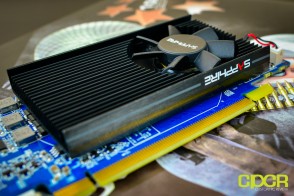 A little while back, we reviewed the Sapphire HD 7770 Vapor-X, which was a custom designed Sapphire card designed to give budget gamers excellent performance for under $150. Today, we’ll be reviewing another Sapphire card that was recently introduced, the Sapphire HD 7750 1GB Low Profile.
A little while back, we reviewed the Sapphire HD 7770 Vapor-X, which was a custom designed Sapphire card designed to give budget gamers excellent performance for under $150. Today, we’ll be reviewing another Sapphire card that was recently introduced, the Sapphire HD 7750 1GB Low Profile.
Now the Radeon HD 7750 isn’t exactly a new graphics card as it’s been out for quite a while and we’ve actually reviewed the HIS HD 7750 all the way back in February, but today we’ll be reviewing the low profile edition of the Sapphire 7750, which is designed to be used in small form factor PCs such as HTPCs for example.
In terms of specifications, the Sapphire HD 7750 1GB Low Profile is pretty much all reference, so it’s got 512 stream processors, 1GB GDDR5 running off a 128 bit memory interface, 16 ROPs, 40 TUs, and a clock speeds of 800MHz core / 1125 MHz memory. This also means that performance wise, we should see results identical to what we saw from the full sized reference HD 7750, except in a smaller package.
Specifications
| AMD Radeon HD 7750 | Sapphire HD 7750 LP | |
|---|---|---|
| Fabrication | 28nm | 28nm |
| Core Clock | 800MHz | 800MHz |
| Stream Processors | 512 | 512 |
| Texture Units | 40 | 40 |
| ROPs | 16 | 16 |
| Buffer Size | 1GB GDDR5 | 1GB GDDR5 |
| Memory Interface | 128-bit | 128-bit |
| Memory Frequency | 1125MHz (4.5 GHz Effective) | 1125MHz (4.5 GHz Effective) |
[section label=2. A Closer Look]
A Closer Look at the Sapphire HD 7750 1GB Low Profile
Sapphire’s packaging looks pretty cool even though the HD 7750 1GB Low Profile is meant to be used in smaller form factor PCs such as HTPCs or MiniPCs.
Inside we get more accessories than usual. Along with the documentation and the driver disk, we get a VGA to DVI adapter, a mini-HDMI to HDMI adapter, a mini Display Port to Display Port adapter, and a full size expansion slot bracket.
With accessories out of the way, let’s take a look at the HD 7750 Low Profile itself. As this card is designed to fit into small form factors such as the mITX formfactor, it’s very small. Sapphire has gone with a blue PCB and a very small, single slot heatsink.
Sapphire chose to use quite a small heatsink on this graphics card, but the HD 7750 runs fairly cool, so it shouldn’t be an issue. Remember, the HD 7750 does not require external PCIe power. All power needed is delivered through the PCIe slot.
Sapphire has included the perfect mix of outputs here with DVI out, mini-HDMI out, and mini-Display Port out.
Unlike full sized HD 7750 graphics cards, the Sapphire HD 7750 Low Profile has a lot of stuff going on in the back of the PCB.
For those who want to use the HD 7750 Low Profile with a case with full sized expansion slots, Sapphire has included a full sized expansion slot adapter.
[section label=3. Testing Setup]
Sapphire HD 7750 Low Profile Performance
Testing Setup
Ivy Bridge Test Bench
Due to Ivy Bridge systems becoming much more mainstream these days, we’ve updated our older Sandy Bridge graphics testing system to our new Ivy Bridge test system with the specifications below. All graphics cards reviewed today have been retested on the new setup and scores from older graphics card reviews may no longer be used in direct comparison.
Since we’ve updated our test bench and our test suite, we decided to run a full suite of benchmarks on the Sapphire HD 7750 Low Profile despite results that should be identical to those off the HIS 7750 iCooler.
| CPU | Intel Core i5 3570K |
|---|---|
| Motherboard | Gigabyte Z77X-UD3H |
| Memory | Kingston HyperX Genesis 16GB DDR3 2133MHz |
| Graphics | N/A |
| Boot Drive | OCZ Vertex 4 128GB SSD |
| Storage Drive | Western Digital Caviar Green 3TB |
| Power Supply | Corsair HX650 |
| Case | HSPC High Speed Tech Station |
| Optical Drive | ASUS OEM DVD Drive |
| Operating System | Windows 7 Ultimate x64 SP1 |
Special thanks to Gigabyte, Kingston, OCZ Technology and HSPC for sponsoring our test bench!
Initial Boot
[section label=4. 3D Mark 11]
Sapphire HD 7750 Low Profile Performance
3D Mark 11
3D Mark 11 is an extremely popular benchmark designed by Futuremark for the sole purpose of stress testing a system’s graphics performance. Trusted by hardware enthusiasts and gamers world wide, 3D Mark 11 uses the latest features of DX11 to stress test graphics performance with consistent loads which simulate in game performance.
[section label=5. Unigine Heaven]
Sapphire HD 7750 Low Profile Performance
Unigine Heaven v3.0
Unigine Heaven is another DX11 benchmark that stresses the graphical processing capabilities of the GPU using the advanced UNIGINE engine.
[section label=6. Lost Planet 2]
Sapphire HD 7750 Low Profile Performance
Lost Planet 2
Despite being released by Capcom in 2010, this third person shooter is still a staple in many gaming benchmark suites. Featuring a vast world, detailed environments, and stunning effects, Lost Planet 2 can still be more than a handful for even many of today’s gaming graphics cards.
For our benchmarking today, we’ll be using the “Test A” preset in the Lost Planet 2 benchmarking utility.
[section label=7. Shogun 2: Total War]
Sapphire HD 7750 Low Profile Performance
Shogun 2: Total War
Shogun 2: Total War is the most recent installment of the long running Total War series. Capable of using DX11’s features, it’s the perfect benchmark to test for the gaming performance. For our testing today, we’ll be using the Shogun 2: Total War benchmark utility.
[section label=8. Crysis 2]
Sapphire HD 7750 Low Profile Performance
Crysis 2
As the successor to Crysis, which was hailed as the most graphically intensive game of all time when it was released in late 2007, Crysis 2 is less graphically demanding than its predecessor, but still one of the most graphically challenging games of all time. You simply can’t take a step in Crysis 2 without stepping into some intense tessellation. Combined with rich lighting, insane physics, and oodles of post processing, Crysis 2 requires a ton of graphics muscle to run.
Today, we’ll be benchmarking Crysis 2 in the map “Central Park” with the Crysis 2 Benchmark Tool.
[section label=9. Metro 2033]
Sapphire HD 7750 Low Profile Performance
Metro 2033
Similar to Crysis 2, Metro 2033 is extremely tessellation intensive and fills the ranks as one of the most graphically intense games of all time.
Today, we’ll be benchmarking Metro 2033’s Frontline map using the Metro 2033 Benchmark Utility.
[section label=10. Diablo 3]
Sapphire HD 7750 Low Profile Performance
Diablo 3
After being released over a decade after its predecessor, Diablo 2, Diablo 3 launched as the fastest selling PC game of all time selling 3.5 million copies within the first 24 hours of its release, instantly crushing Blizzard’s servers at launch time. While Diablo 3 isn’t the most graphically intense game out there, it’s still an excellent benchmark due to its widespread popularity.
For our benchmarking today, we’ll be using FRAPS to record a 60 second benchmark while in game. Our benchmark is run in Act 4 Part 1 where we’ll be taking out the mini-Boss Istaku and his countless minions.
[section label=11. Battlefield 3]
Sapphire HD 7750 Low Profile Performance
Battlefield 3
Possibly one of the most highly anticipated FPS games of 2012, Battlefield 3 is currently one of the most graphically intensive games developed on the incredibly well crafted Frostbite 2 engine. With its detailed models, amazing physics, excellent use of shaders, and stunning effects, it easily makes it into our list of the best looking games ever created.
Our benchmark will be run in the map Operation Firestorm during the first fight scene. We’ll be using FRAPS to record a 60 second clip, which includes making this van up here explode.
[section label=12. Power Consumption and Temperatures]
Sapphire HD 7750 Low Profile Performance
Power Consumption
Temperature Testing
[section label=13. Overclocking]
Sapphire HD 7750 Low Profile Overclocking
Overclocking performance was near identical to what we saw on the HIS 7750 iCooler. The Sapphire HD 7750 Low Profile was able to hit 890MHz core and 1175MHz memory, which is quite a significant overclock. Unfortunately, the card is locked for voltage, so there isn’t a whole lot of room for overclocking. That said, those looking to purchase this card probably isn’t looking to break overclocking records with it.
3D Mark 11 Performance
Performance wise, we’re looking at around an 8% increase, which isn’t too bad. This could mean a significant difference in some games that are borderline playable.
Power Consumption
Since there isn’t much opportunity to increase the voltage or external PCIe power, there isn’t much difference in power consumption. Our overclock only drew an additional 5w under load. Not bad.
Temperatures
As expected, temperatures rose a bit after the overclocking pushing the Sapphire HD 7750 Low Profile slightly above 71ºC. 71ºC is fine. It’s not the end of the world. That said, the fan spun faster and got significantly louder as well. It seems like the fan is set to keep the graphics card under 70ºC.
[section label=14. Conclusion]
Sapphire HD 7750 Low Profile Conclusions
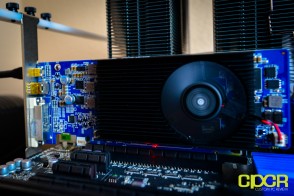 Lately, the mini-ITX form factor has become quite popular with enthusiasts who want a powerful PC in a small form factor and while Intel’s latest Sandy Bridge and Ivy Bridge processors are pushing the boundaries in terms of CPU performance, GPU performance has been lagging. Prior to the HD 7750 Low Profile, the only options were last generation Radeon cards such as the HD 6570 or the HD 6670, or the Nvidia GT 640, all of which (to put bluntly) suck when it comes to gaming performance.
Lately, the mini-ITX form factor has become quite popular with enthusiasts who want a powerful PC in a small form factor and while Intel’s latest Sandy Bridge and Ivy Bridge processors are pushing the boundaries in terms of CPU performance, GPU performance has been lagging. Prior to the HD 7750 Low Profile, the only options were last generation Radeon cards such as the HD 6570 or the HD 6670, or the Nvidia GT 640, all of which (to put bluntly) suck when it comes to gaming performance.
Now, I’m not saying that the HD 7750 is a card that’ll run every game at 1080p, max settings as it does have its limitations, but those who don’t mind playing games at 1680×1050 at medium settings can expect to play most games at acceptable framerates. Those who play less graphically intensive games such as Diablo 3 can even expect the Sapphire HD 7750 Low Profile to dish out very playable framerates at 1920×1200 on high settings. Need a new, portable mini-ITX LAN-box to play Diablo 3, Starcraft 2 or some League of Legends? Throw the Sapphire HD 7750 Low Profile in your new rig and you’ll be good to go.
Current pricing on the Sapphire HD 7750 1GB Low Profile is $114.99 on Newegg, which puts it in the budget range for a graphics card. The lowest price for a full sized Radeon HD 7750 such as the Sapphire Radeon HD 7750 is currently $104.99 on Amazon, so the low profile edition of the card is going to cost a $10 premium over the standard Radeon HD 7750. That said, there aren’t really any options when you absolutely need low profile in order to fit a certain case, and still want to be able to play games.
Bottom Line
The Sapphire HD 7750 1GB Low Profile is currently the best choice for gamers who absolutely need a low profile graphics card.
Special thanks to Sapphire for making this review possible.
The Sapphire HD 7750 1GB Low Profile is currently available on Newegg.

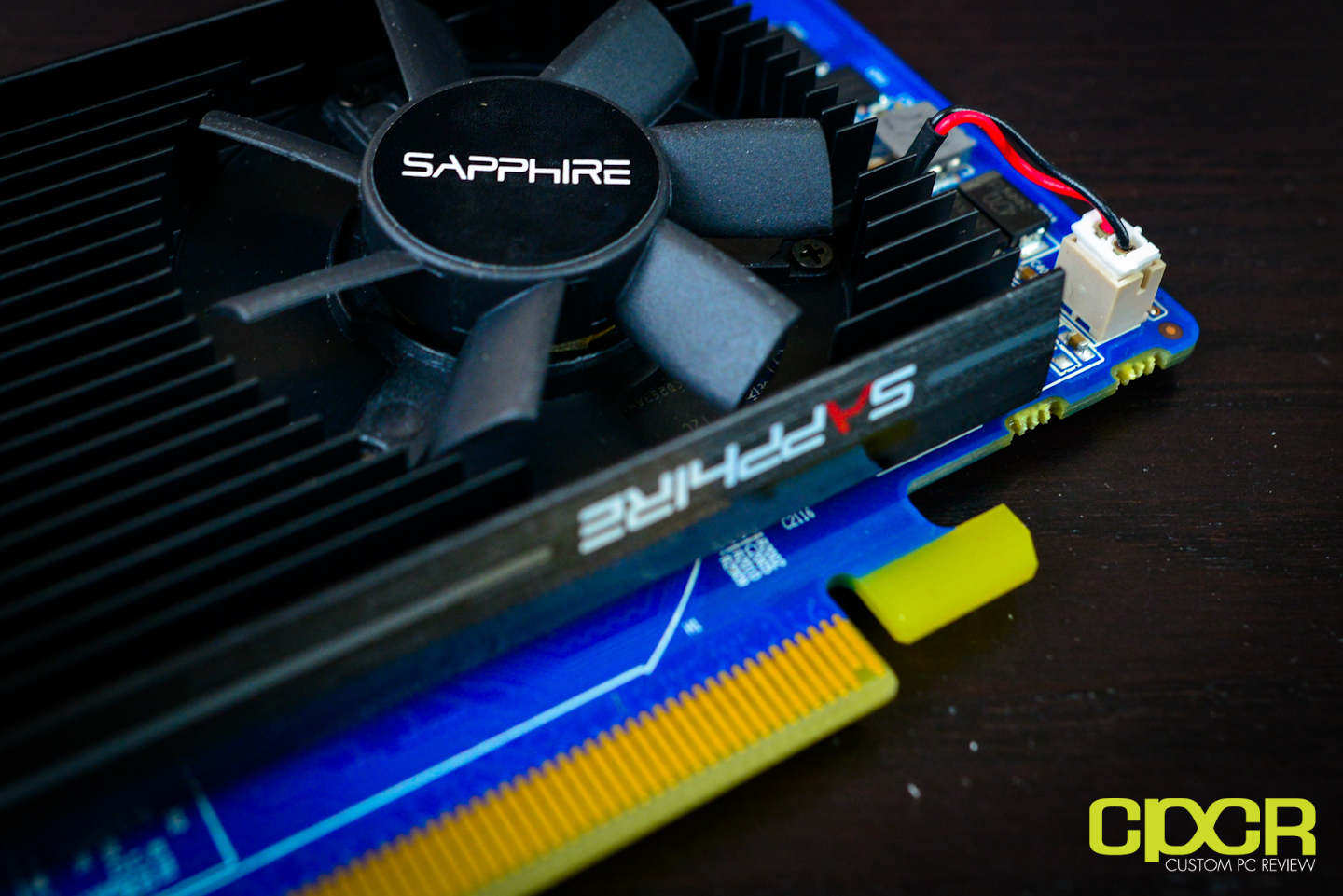
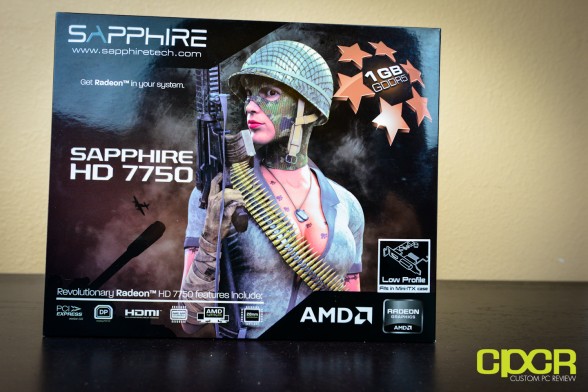
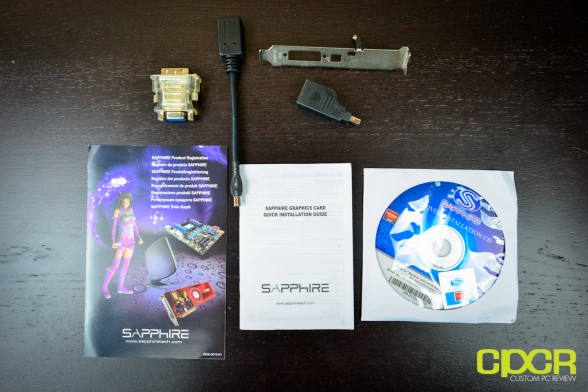
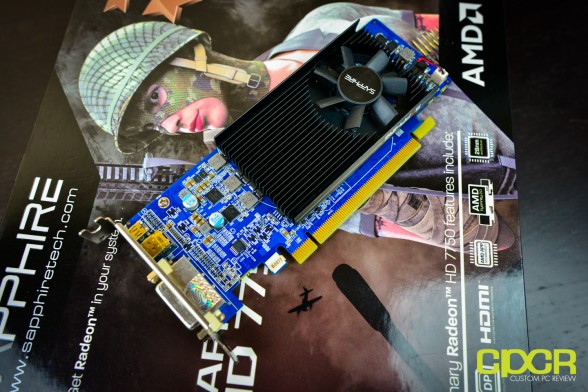
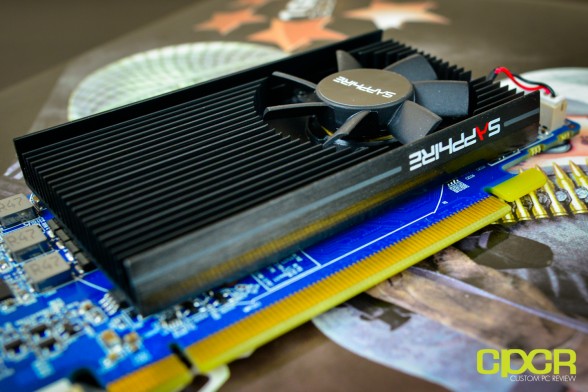
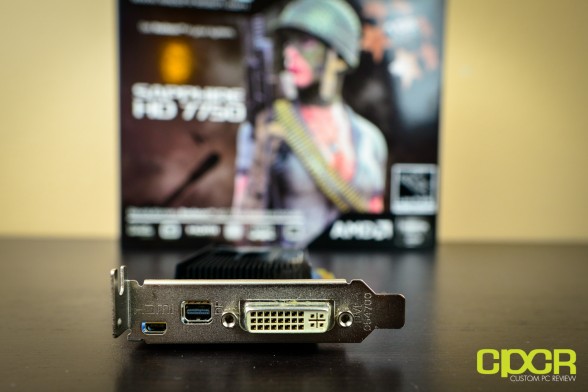
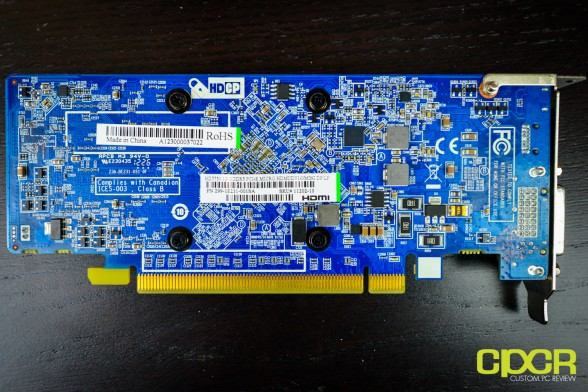
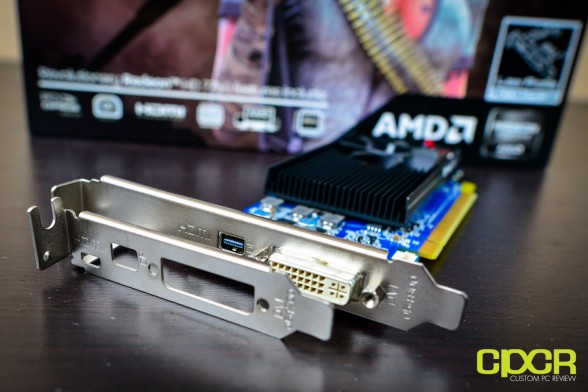
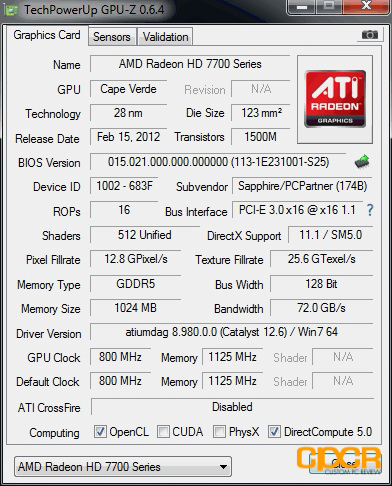
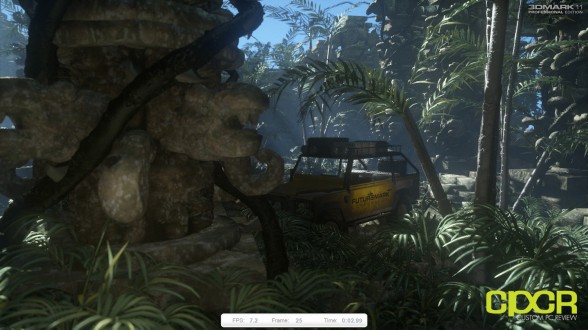
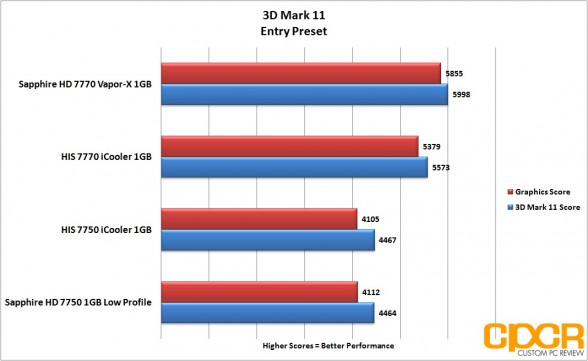
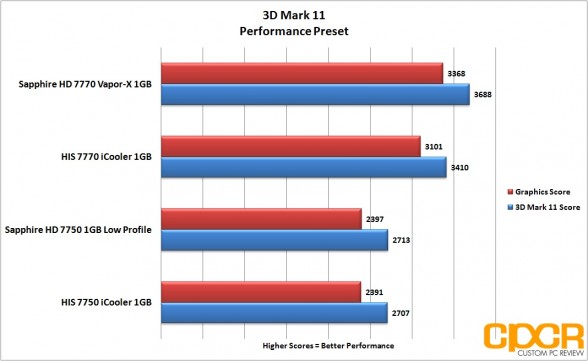
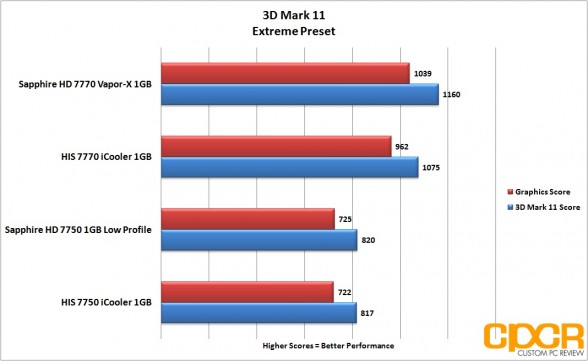
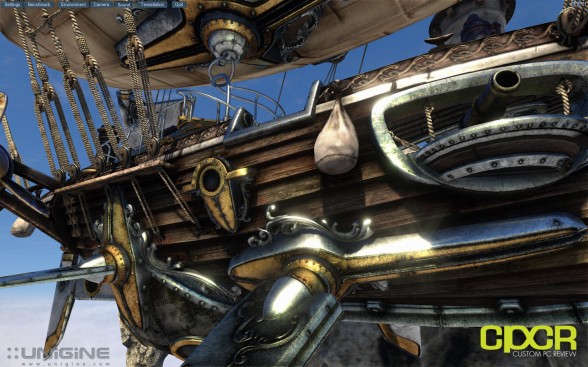
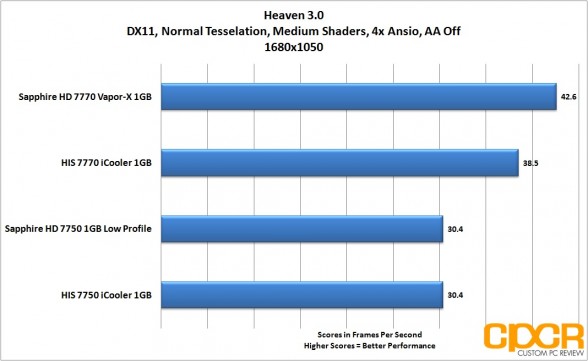
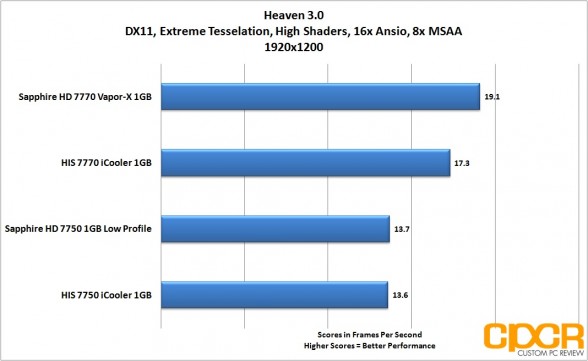
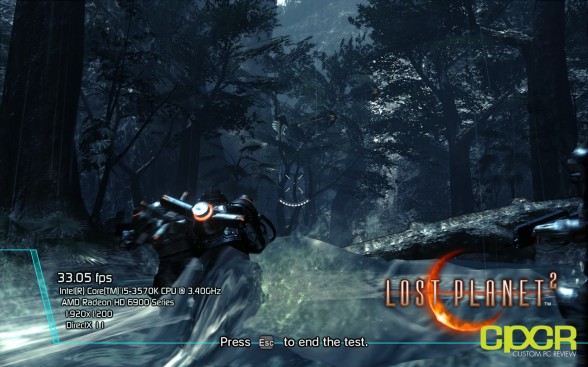
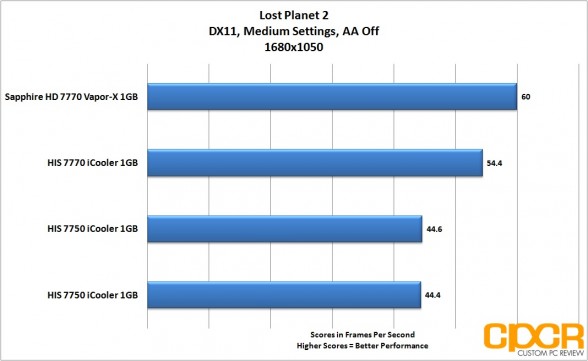
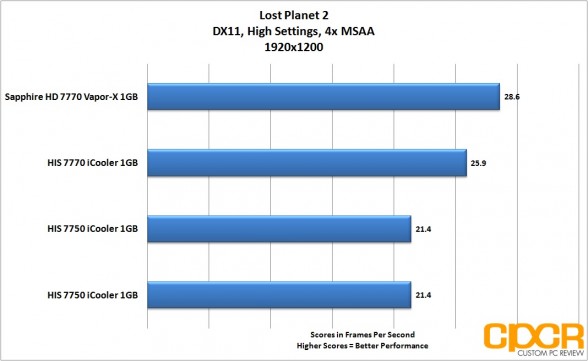
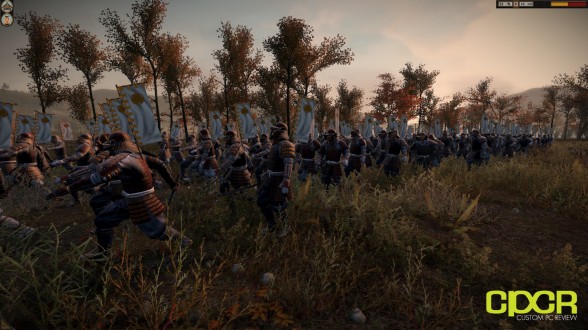
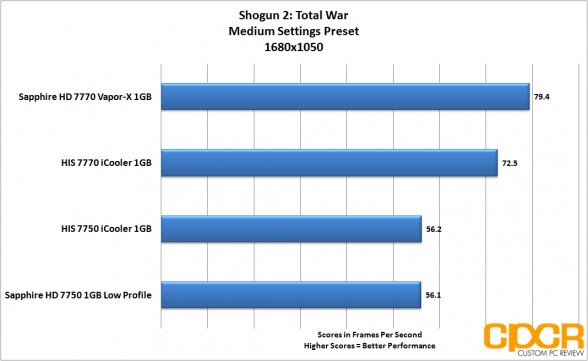
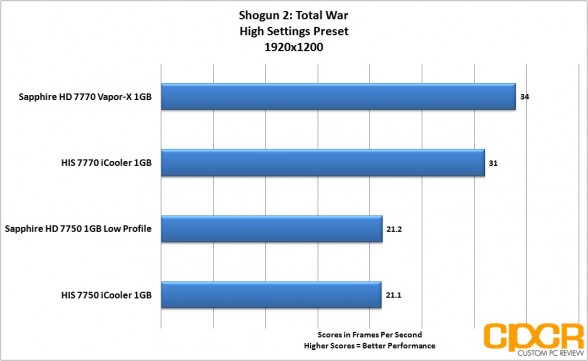
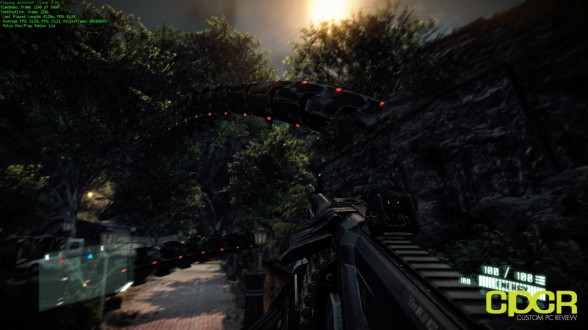
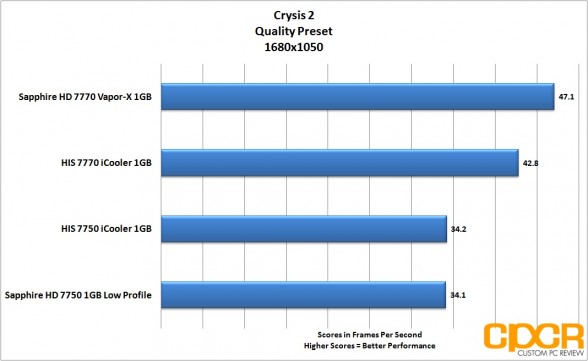
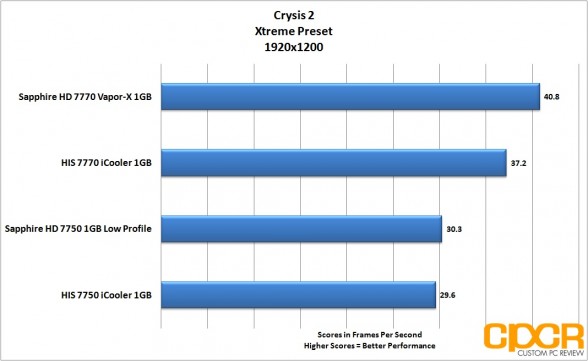
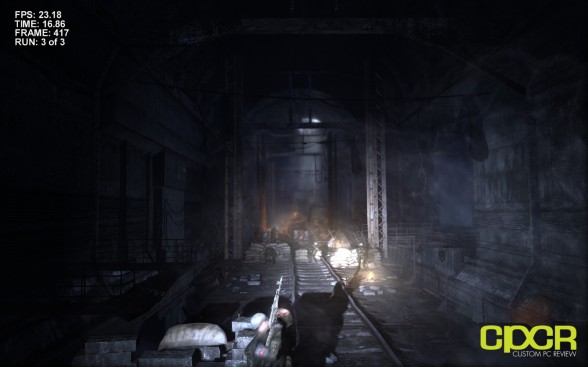
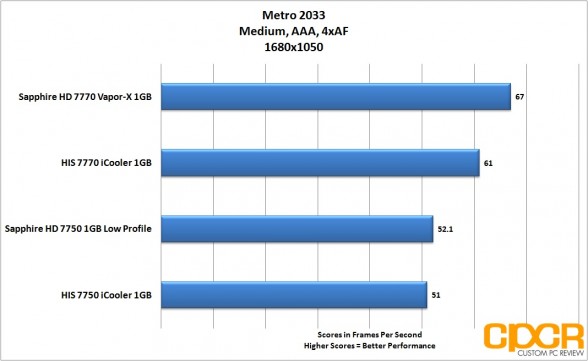
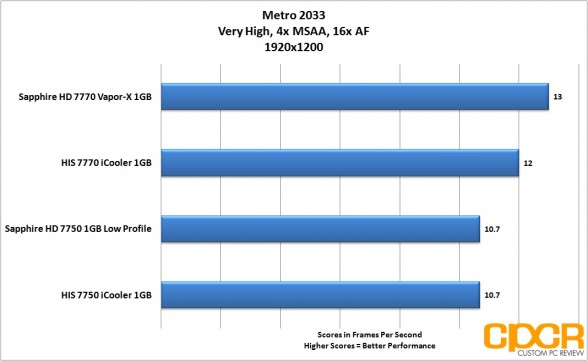
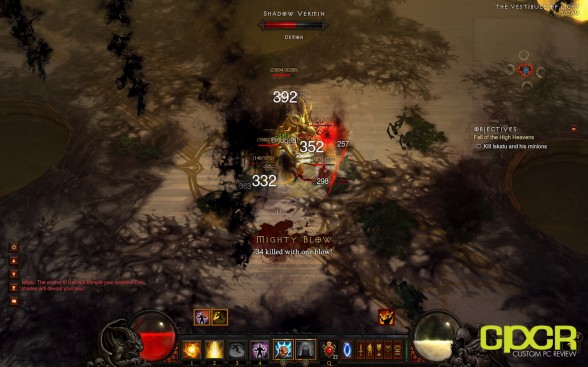
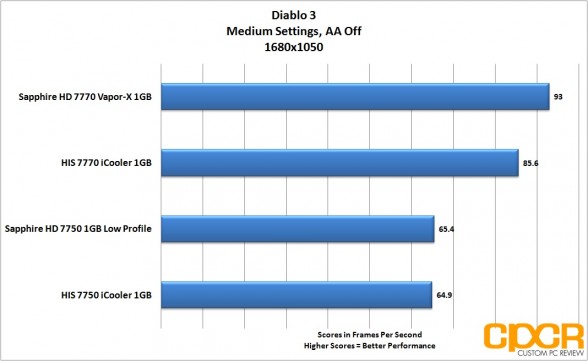
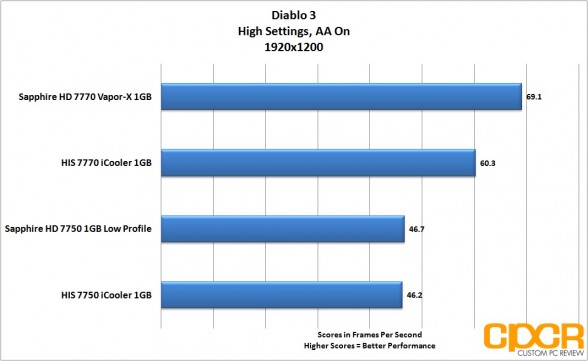
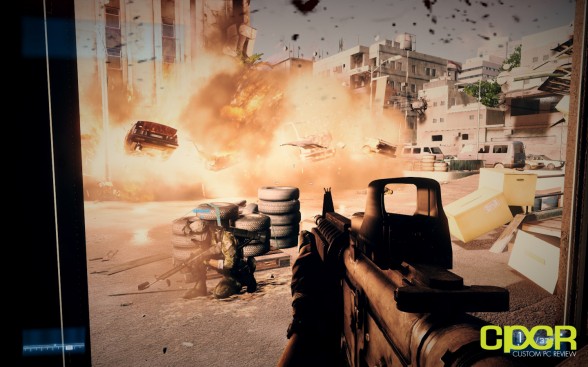
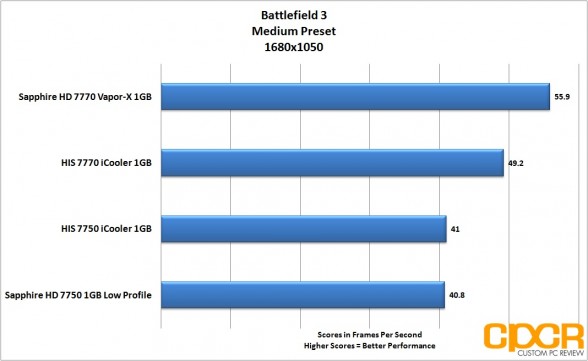
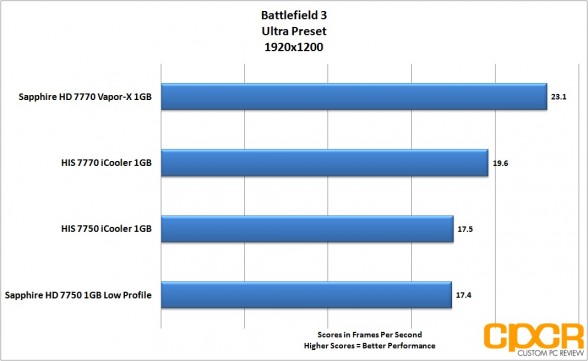
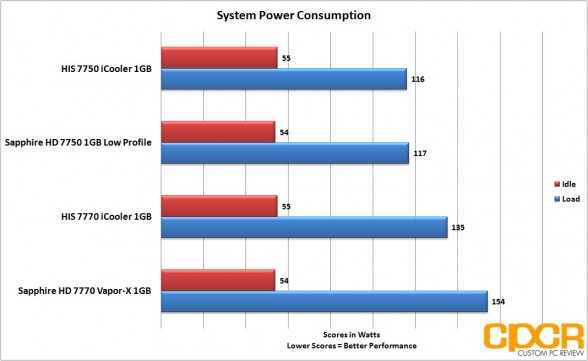
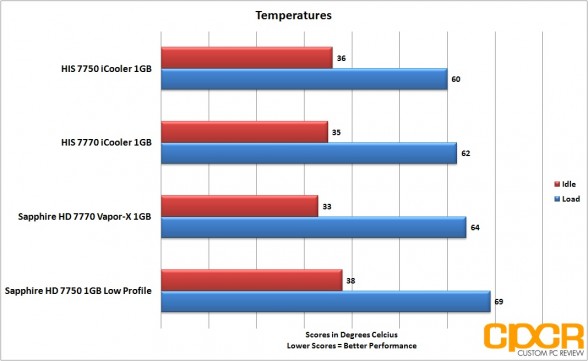
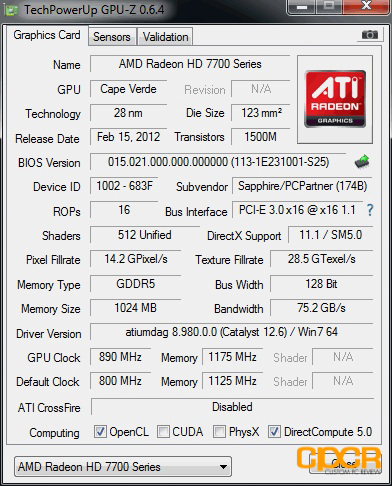
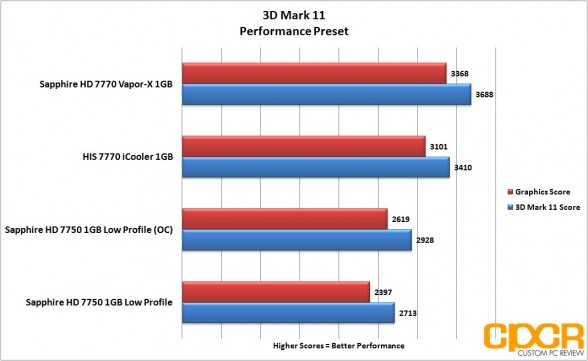
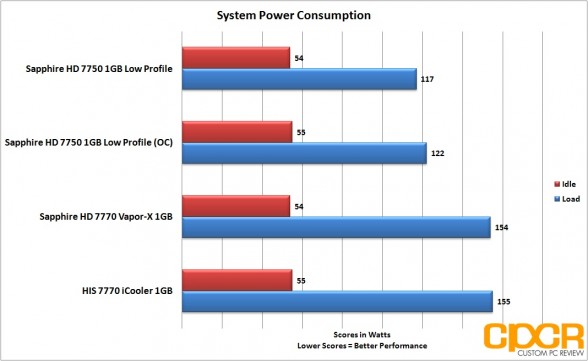
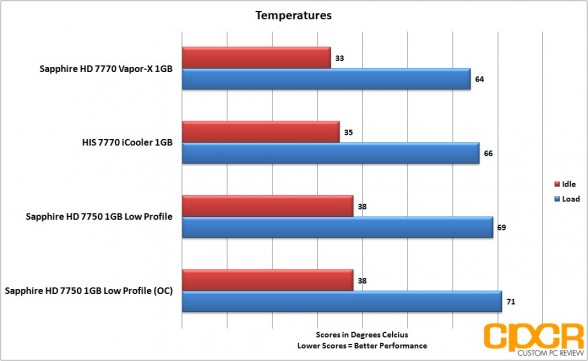
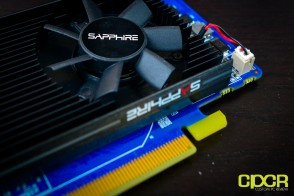

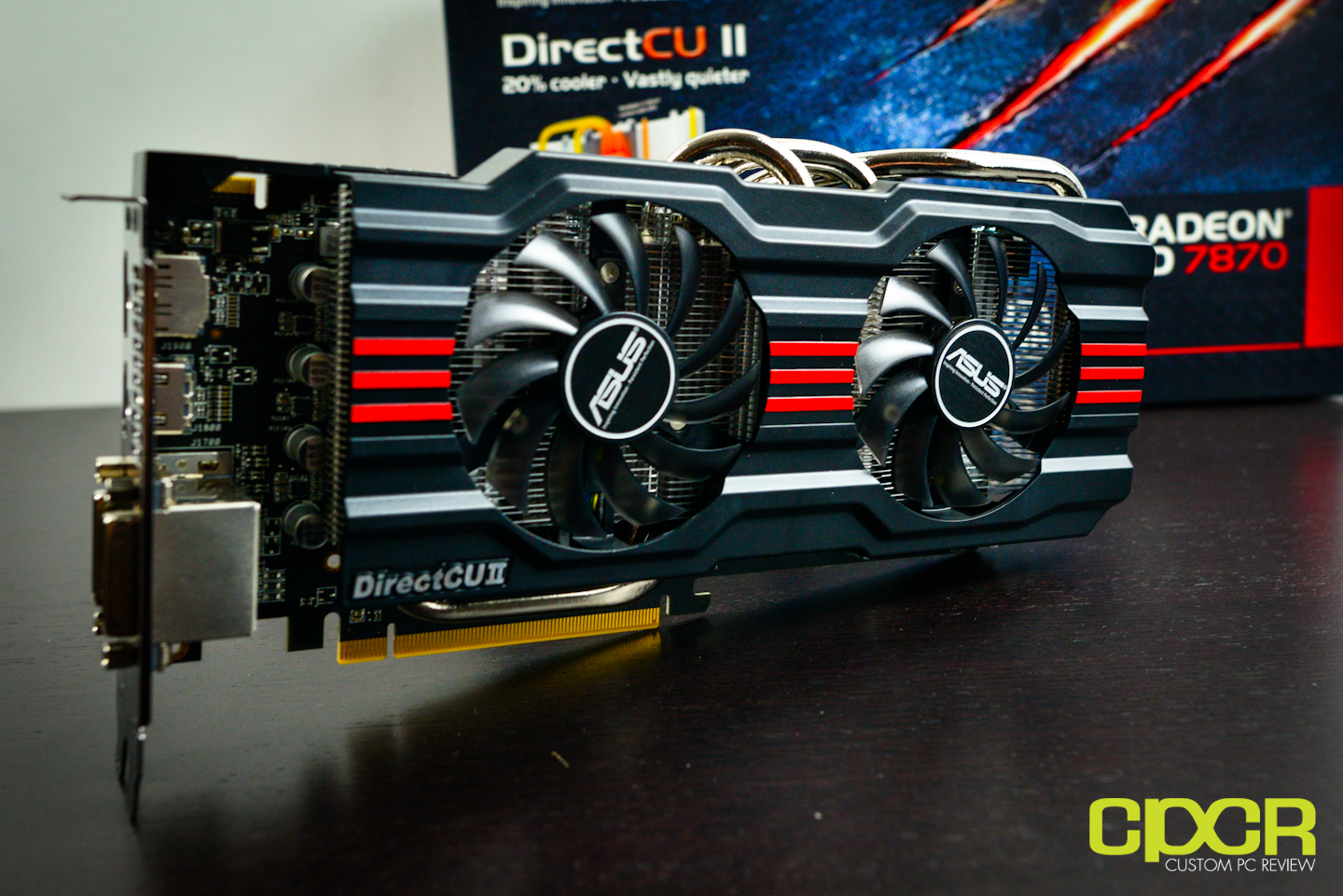
![ROCCAT Kone [+] Gaming Mouse Review](https://www.custompcreview.com/wp-content/uploads/2012/09/roccat-kone-+-custom-pc-review-121.jpg)
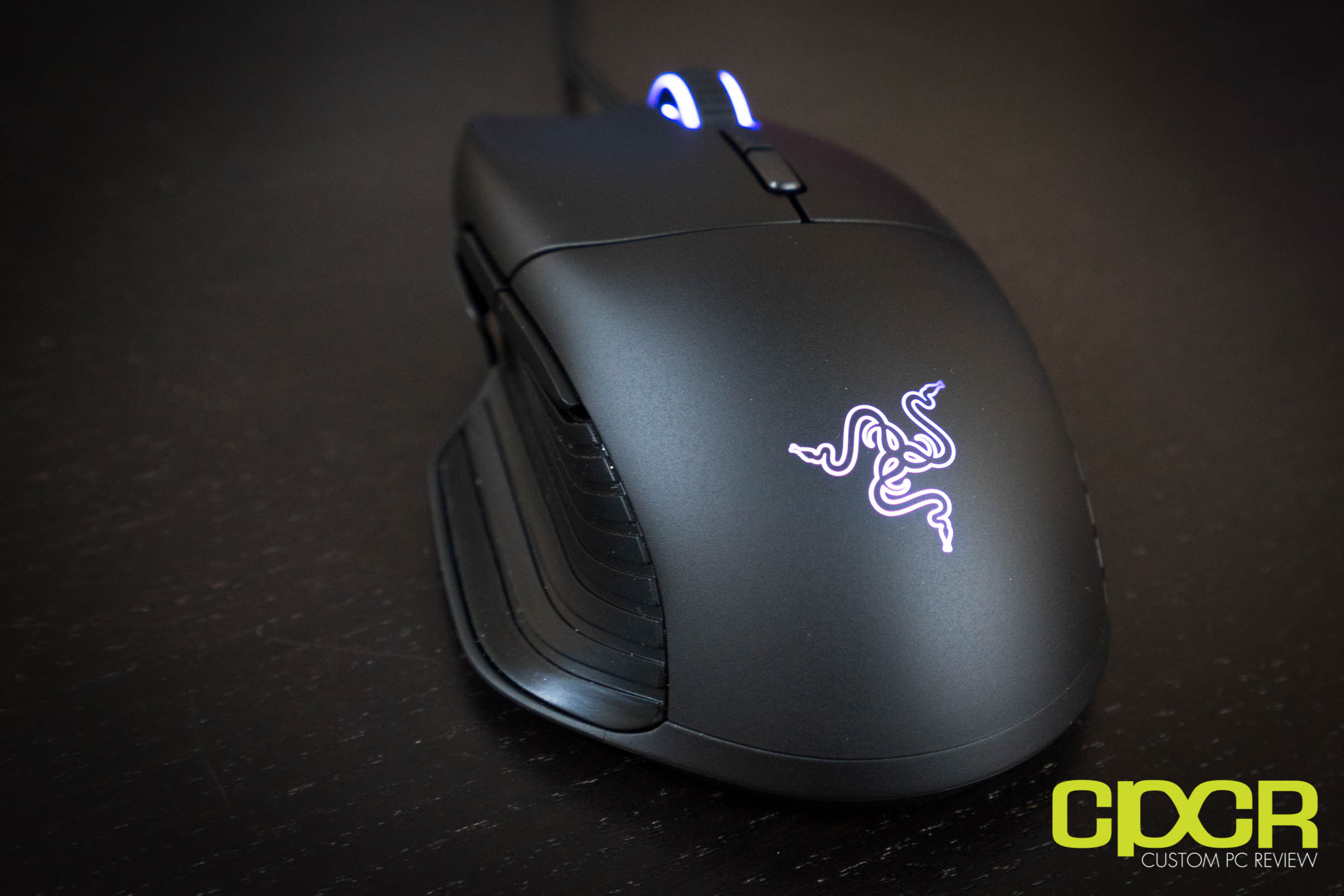

Man, this is the HTPC darling, and there’s nothing Nvidia can counter in this form factor. I’d like to see Sapphire do a Silent Vapor-X (no fan) version. Employing two small heat-pipes that maybe could wrap over the edge to the back-side kind of like what they had with the 6450. The heat pipe a Vapor chamber would have fairly dense cooling fins. It’s not so much for silence it just that for full time HTPC use fans gather dust bunnies and then start to fail. Guy’s wanting a card like this would built it into a client’s media enclosure and those users won’t be the one to ever open thing up to blow things out. One less fan isolated inside the chassis might never get checked till it’s too late.
What can it do it Battlefield 3?
It doesnt have a 6 pin rail to draw 117 watts and the PCI bus only supplies 75 watts – how the hell is it getting 117 watts under load?
117w is total system power consumption. This includes the CPU, memory, SSD, etc. Not to mention the PSU isn’t 100% efficient, so tack on another ~20% for efficiency as well.